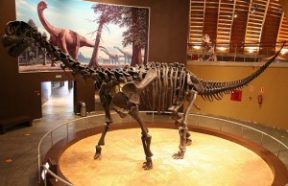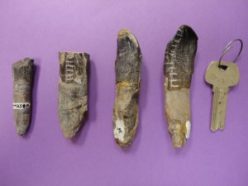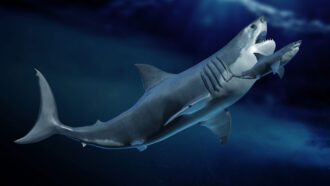Dino teeth tell a traveling tale
Dental evidence from sauropods suggests the mighty beasts migrated for food
Animals migrate to survive. Golden eagles head south for the winter, salmon swim upstream to lay eggs and locusts move on when it gets too crowded. Scientists now say that 150 million years ago, plant-eating dinosaurs called sauropods living in North America may have migrated, too. The new study suggests these enormous animals traveled at the change of the seasons, leaving dry riverbeds in search of well-watered areas thick with plants.

Henry Fricke, a geologist from Colorado College in Colorado Springs, led the study of the ancient animals. His team says that sauropod migrations might help explain how the long-necked dinos got so big.
Other scientists have suggested sauropods got so big because they needed giant stomachs to digest plant food. Over many generations, as the animals’ stomachs got bigger, so did their bodies. Fricke says that’s possible, but he thinks migration played a part, too.
The dinos’ giant size kept them safe from smaller, sharp-toothed, carnivorous dinos, like Allosaurus. An Allosaurus-sauropod fight would be similar to “a bunch of hyenas trying to attack an elephant,” Fricke told Science News. “Once sauropods reached their full size, they were effectively immune to predation.”
In his work, Fricke studies the chemicals in minerals and fossils to learn what the environment was like hundreds of millions of years ago. But in this case, he and his team compared the chemicals in minerals with those in the teeth of sauropods called Camarasaurus to discover the dinosaurs’ wandering ways. He told Science News that an animal’s teeth give clues to where the animal lived.
“When animals drink water, the oxygen in that water gets incorporated into the bloodstream and eventually into tooth enamel,” Fricke explained.
Oxygen comes in different forms, called isotopes. Different sources of water may contain different isotopes, so the oxygen in a mountain stream may be slightly different from the oxygen in swamp water.

Fricke and his colleagues compared isotopes in the dino tooth enamel with isotopes in minerals near where the teeth had been excavated. The scientists found different levels in the teeth and the minerals, which suggests the sauropods had another source of water.
Next, Fricke wants to look for similar patterns in the tooth enamel of smaller sauropod species, like Stegosaurus. If smaller dinos stayed in one place all year, then Fricke might have found another clue in the connection between migration and sauropods’ giant size.
POWER WORDS (adapted from the New Oxford American Dictionary)
sauropod A very large, four-legged, plant-eating dinosaur with a long neck and tail, small head and massive limbs.
geology The scientific study of Earth’s physical structure and substance, its history and the processes that act on it.
paleontology The scientific study of fossil animals and plants.
migration Movement from one region or habitat to another, especially regularly and according to the seasons.
enamel A thin but hard substance that covers teeth.







